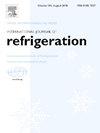Optimization of heat transfer mechanisms in elastocaloric cooling systems
IF 3.8
2区 工程技术
Q1 ENGINEERING, MECHANICAL
International Journal of Refrigeration-revue Internationale Du Froid
Pub Date : 2025-09-26
DOI:10.1016/j.ijrefrig.2025.09.022
引用次数: 0
Abstract
Elastocaloric cooling has swiftly emerged as a promising cutting-edge solid-state cooling technology, offering environmentally friendly and efficient alternatives to conventional cooling systems. To enhance the performance of the elastocaloric cooling system, the primary strategy involves increasing the operational frequency and specific heat transfer area. This study investigates the heat transfer mechanisms within the elastocaloric regenerator, focusing on the time scales associated with different heat transfer modes, namely conduction and convection. A novel non-dimensional design variable, thermal utilization ratio (Z*), is introduced to evaluate the performance of elastocaloric systems. Using a numerical model, the cooling capacity and temperature lift of a tubular NiTi elastocaloric cooling system were optimized with respect to Z*. Additionally, the effect of the optimized Z* parameter for the elastocaloric system was studied by simulating different materials and geometries. This analysis provided a relation between the optimum value of Z* for different elastocaloric materials and geometries, providing critical insight into the selection of design parameters for maximizing the performance of elastocaloric cooling systems.
弹性热冷却系统中传热机制的优化
弹性热冷却已迅速成为一种有前途的尖端固态冷却技术,为传统冷却系统提供了环保和高效的替代方案。为了提高弹性热冷却系统的性能,主要策略包括提高工作频率和比传热面积。本文研究了弹性热蓄热器内的换热机制,重点研究了不同换热方式(即传导和对流)的时间尺度。引入了一种新的无量纲设计变量热利用率(Z*)来评价弹性热系统的性能。利用数值模型,对管状NiTi弹性热冷却系统的制冷量和温度升程进行了Z*的优化。此外,通过模拟不同的材料和几何形状,研究了优化后的Z*参数对弹性热系统的影响。该分析提供了不同弹性热材料和几何形状的Z*最佳值之间的关系,为最大化弹性热冷却系统性能的设计参数的选择提供了关键的见解。
本文章由计算机程序翻译,如有差异,请以英文原文为准。
求助全文
约1分钟内获得全文
求助全文
来源期刊
CiteScore
7.30
自引率
12.80%
发文量
363
审稿时长
3.7 months
期刊介绍:
The International Journal of Refrigeration is published for the International Institute of Refrigeration (IIR) by Elsevier. It is essential reading for all those wishing to keep abreast of research and industrial news in refrigeration, air conditioning and associated fields. This is particularly important in these times of rapid introduction of alternative refrigerants and the emergence of new technology. The journal has published special issues on alternative refrigerants and novel topics in the field of boiling, condensation, heat pumps, food refrigeration, carbon dioxide, ammonia, hydrocarbons, magnetic refrigeration at room temperature, sorptive cooling, phase change materials and slurries, ejector technology, compressors, and solar cooling.
As well as original research papers the International Journal of Refrigeration also includes review articles, papers presented at IIR conferences, short reports and letters describing preliminary results and experimental details, and letters to the Editor on recent areas of discussion and controversy. Other features include forthcoming events, conference reports and book reviews.
Papers are published in either English or French with the IIR news section in both languages.

 求助内容:
求助内容: 应助结果提醒方式:
应助结果提醒方式:


